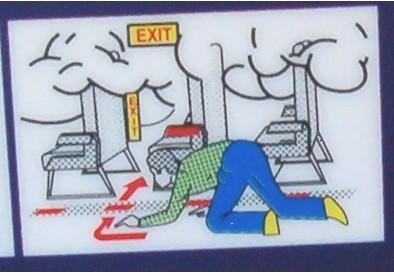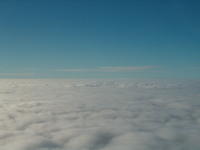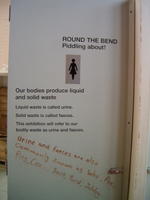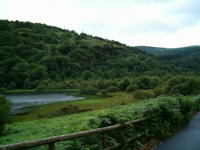Socialight
Tuesday, September 18, 2007
Food only a Brit could love
I will kick off my first blogger post in over two years with a tribute to the cuisine of great Britain.
My fiance and I went shopping at World Market a few weeks ago. I stumbled across a jar of Marmite in the international foods aisle. This got me misty eyed and sentimental about my days in dear old Britannia. Marmite is a foul smelling, nasty tasting yeast extract that is a byproduct of brewing. Some industrious British brewer concluded that he could make money off it by selling it to his countrymen. Every morning the college would provide us with single serving Marmite packages, presumedly to spread thinly over our toast. The phrase "spread thinly," appears all over Marmite packages. They don't want to be sued.
I ate Marmite twice while I was in England. I ate it the first time on a dare. The second time convinced my classmates that they were in the presence of someone tough enough to make Samuel L. Jackson and Chuck Norris scream in terror like a couple of sissy school girls. I bought a jar to gross my fiance out. It makes me feel tough to know that I can eat Marmite and survive. I'll probably have a bit on toast to remind myself that I can get through whatever troubles life is throwing on me. I explained to my fiance that Marmite is like the bitter herbs on the Passover Seder, which remind you to be thankful about the rest of life even in the midst of suffering.
The marketing wizards at Marmite are proof that genius thrives best under opposition. Their advertising slogan is "Marmite: You either love it or hate it." They've come up with some great T.V. spots. Marmite pulled the ad shown above off the airwaves because a bunch of parents complained that it gave their kids nightmares.
Friday, August 12, 2005
Winding Down, Heading Home
Tonight we are getting dressed up and heading to Maddingly Hall for our farewell dinner. It's been a busy week. After another all-nighter to finish my second essay, I spent my final week enjoying the sights around Cambridge. Steven J. and I went on an 8 mile hike around Audley End and visited Audley End house, a Jacobean mansion built to entertain visiting royalty. We hiked through fields of wheat and startled four large dear (two bucks and two does) while they were feeding. I saw two open air Shakespeare plays (a so-so Macbeth and an excellent Taming of the Shrew)and ate at a Spanish Tapas bar and a Turkish restaurant (fried lambs liver is dee-lish). My favorite afternoon was spent in a walk down the river to Granchester, a small village about a mile away. We had tea and cakes (treacle tart- much better than it sounds) at the Orchard, a famous but low key Victorian out door tea house frequented by the likes of Virginia Woolf, Bertrand Russell, Wittgienstien (sorry about the spelling)and Sylvia Plath. Today Brittany and I went punting down the river- by ourselves. It was awful. We couldn't get the punt straight and kept hitting other tourists and running over ducks. I'm sure we'll laugh about it later. I'll be staying in London with Laura for the next two days and visit various museums, stately houses, and some musical that she really wants to go to. I'll arrive back in the U.S., God willing, at around 4 PM EST Monday. I look forward to seeing all my Gainesville friends soon!
Wednesday, August 10, 2005
What's Wrong With This Picture?

Ryanair had the honor of flying us safely to Dublin and back. The plane rides were bumpy, crowded, and featured several delays. The seats were so uncomfortable that they evidently damaged the rear end of poor fellow in the safety procedure cartoon (please look closely at the 4th panel from the right on the bottom row). OUCH!!!




The Guinness Factory



During our Dublin visit, we made the obligatory pilgramage to the Guinness factory. At the end of the tour, you get a free pint in glass walled bar overlooking the city. Needless to say, we spent a few hours enjoying the authentic Irish pubs. One of the pictures features Steven L. and myself (in some very natty hats) before I had whiskey, and another picture shows what Steven J. and Chris looked like after I had whiskey.
Dublin Pictures





Here's a few pictures of the Irish sea and a couple of the sights in Dublin. The picture of the large pole is the monument erected by the city government to celebrate the millennium. They completed it in 2003. According to our tour guide, the locals hate it: "America-the Statue of Liberty; England-Big Ben; France-The Eiffel Tower; Ireland- a steel pipe." Some Dublin nicknames for the Millenium Spire include "Da Pole in da Hole" and "Da Stilleto in da Ghetto." I also snapped a picture of the exterior of our hostel, Abraham house. It gives you a good idea of a Georgian Dublin streetscape, with terraced buildings and painted doors (just in case you missed the "Doors of Dublin" posters featured in every Irish pub and Bennigan's since 1992). Finally, Steve and I dressed up as Plastic Paddies at Carroll's, the chain of souvenir stores selling cheap crap for tourists.
Friday, July 29, 2005
Dublin
Hello from Dublin. This is one rainy city. As the sign on my tour bus said, "You didn't come to Ireland for the weather." I spent the day with my fellow UF students on a tour through Dublin, Glendalough, and Wicklow. The countryside is beautiful (photos to come) Dublin has a wonderful Georgian (not the Southeast U.S. kind) charm to it. After the tour, I went to the Guiness factory with Steve and Laura. Right now, I'm back at our hostel. We're drying off and trying to figure out what to do for the evening. Step one: change into dry clothing.
Sunday, July 24, 2005
On the wonders of Victorian plumbing...
Hello, all. We've just arrived back to Cambridge after a mandatory weekend excursion to various sites relevant to the Victorian era. Yesterday, we went a place called the Abbey Pumping Station and Museum (for some reason this won't let me insert proper hyperlinks, so we'll do it this way http://www.leicestermuseums.ac.uk/museums/aps.html ) in Leicester (home of the famous John Dudley, Earl of Leicester, for all of you Tudor fans out there). The tagline of this museum is: "Enormous steam beam engines and the famous talking loo!"
The Abbey pumping station was created at the end of the 19th century to pump sewage away from the industrial city of Leicester, where they had an absolutely atrocious infant mortality rate and a high number of deaths from disease due to water contamination. The steam beam engines are, indeed, enormous. The beams weigh over 22 tons. They speculate that they were brought to the pumping station from the ironworks a mile away using a cart pulled by a team of at least 44 horses. They still run the steam beam engines on certain days, and I'm sure that it's an impressive sight. The exterior is quite elegant and the ground floor of the engine room is ornately decorated, even though the workmen (and the occasional city councilman) were the only people that ever saw the interior. There are columns inside trimmed with gold leaf, the interior walls have glazed bricks, and everything is painted and lacquered. They sure took pride in their sewage pumps back then. It's amazing that we have all these municipal services now that we just take for granted. That said, the museum was remarkably dull- except for...
 "Flushed With Pride!" Exhibit description: Ever wondered how the toilet developed and how it works or how much water we waste in a day; or how we get water and use it for washing? Then the 'Flushed With Pride' exhibition will answer these questions plus many others. The display, which features the county's only interactive toilet, [MY COMMENT: DOES THIS IMPLY THAT THERE ARE OTHER INTERACTIVE TOILETS IN VARIOUS ENGLISH COUNTIES? DO THEY EITHER GET THEIR OWN DUKE OR A TALKING LOO? THIS WASN'T ADEQUATELY EXPLAINED) showing you how a toilet works, tells the science, technology and social history of Leicestershire's public health. There are displays of sewers, water pipes, some from Roman times, soap, washing machines and baths. There's even a talking toilet! All come together to tell a story of immense importance.
"Flushed With Pride!" Exhibit description: Ever wondered how the toilet developed and how it works or how much water we waste in a day; or how we get water and use it for washing? Then the 'Flushed With Pride' exhibition will answer these questions plus many others. The display, which features the county's only interactive toilet, [MY COMMENT: DOES THIS IMPLY THAT THERE ARE OTHER INTERACTIVE TOILETS IN VARIOUS ENGLISH COUNTIES? DO THEY EITHER GET THEIR OWN DUKE OR A TALKING LOO? THIS WASN'T ADEQUATELY EXPLAINED) showing you how a toilet works, tells the science, technology and social history of Leicestershire's public health. There are displays of sewers, water pipes, some from Roman times, soap, washing machines and baths. There's even a talking toilet! All come together to tell a story of immense importance.Other features of Abbey Pumping Station: Antique tramcars, steamrollers, buses.


weekend, continued
We spent the night at dorms in Nottingham University. Some blokes went out to "Ye Olde Jerusalem" pub, claiming to be the oldest continuously running pub in England. (I stayed in bed).
And the next day...
This morning, we went to Tramway Village in Derbyshire, just on the edge of the Peak District. This part of the Peak District looked remarkably like western North Carolina near Asheville and Cashiers, which is appropriate as my boyfriend is visiting that part of N.C. this week (Hello Jay and the H family!). Today was very cold and damp. We walked around the Tramway Village, which is on the site of an old quarry. The entire park is devoted to Trams. They've tried to recreate what a village in the late nineteenth century would have looked like, at least the parts of a Village that would have been exposed to tram routes. The place consisted of trams, trams, and more trams. There was also a crazy fair organ from the 1890s that had creepy lacquered statues that moved in time with the music. There were two high points to my visit to Tramway Village: The first occured while I was taking tea and sandwiches with Emily around 11:30. I caught a bit of conversation from the group of middle aged English men at the next table:
First bloke: "You don't see many midgets around these days, do you?"
Second bloke: "No, you're right. You don't see many midgets around. Why is that, do you think?"
We spent the rest of the afternoon at an early industrial mill (the name of which I have already blocked out). The afternoon was gray, cold, and rainy. People whined a lot, and the tour was remarkably dull. I am very happy to be back at St. Catherine's. I'm going to spend the rest of the evening doing early research for my second paper, and then try to figure out what I want to do in Ireland this upcoming weekend.
Cheers!
Friday, July 15, 2005
Fireworks at King's College
I spent the late evening with classmates Emily and Stephan at the Sherlock Library in St. Catherine's College . We have keys to the college and to the library, which we can access 24/7. This is helpful, as we are not actually allowed to remove the books from the library and take them back to our flats. It's strange how they manage things here...leaving windows open, not having air conditioning- it can't be good for the books. Then again, none of the books in that room are particularly rare or valuable. I'm attempting to familiarize myself with the poetry of Gerard Manley Hopkins. I sat for an hour on a window seat next to an open window. The sun doesn't fully set until after 9:30 here, and there fresh are and the views are lovely.
 Shortly after dark, we heard fireworks going off outside. We couldn't see them from the windows, so we decided to take a break and run down to the court to get a better view. After vacillating over whether to wait or go, we jogged to the front of King's College. Evidently, there was some sort of celebration. I've never been much of a fan of fireworks before, as I've tended to associate them with strained family trips to Disney World. There was something so exciting and joyous and spontaneous about unexpectedly encountering the fireworks in this setting. There were pauses of a minute or so between bursts of explosions. We stood on the stone border wall outside of King's gate and hoped that the show hadn't ended, and all of a sudden another colorful explosion would appear. The fireworks lasted for another five minutes or so as we stood there. You couldn't have asked for a lovlier back drop than King's College, except of course for King's College as seen from the river.
Shortly after dark, we heard fireworks going off outside. We couldn't see them from the windows, so we decided to take a break and run down to the court to get a better view. After vacillating over whether to wait or go, we jogged to the front of King's College. Evidently, there was some sort of celebration. I've never been much of a fan of fireworks before, as I've tended to associate them with strained family trips to Disney World. There was something so exciting and joyous and spontaneous about unexpectedly encountering the fireworks in this setting. There were pauses of a minute or so between bursts of explosions. We stood on the stone border wall outside of King's gate and hoped that the show hadn't ended, and all of a sudden another colorful explosion would appear. The fireworks lasted for another five minutes or so as we stood there. You couldn't have asked for a lovlier back drop than King's College, except of course for King's College as seen from the river.
Cambridge
Hello, everyone. I've been at Cambridge since Sunday evening. We've finally gotten out of traveling tourist mode and have more or less transitioned to busy student mode. Some of you have asked what it is that I am actually doing in Cambridge. Over the course of five weeks, I will be participating in the International Summer School program with a group of thirty five other UF students. We are studying English and Irish Victorian history and literature at St. Catherine's College at Cambridge University. We attend lectures and are required to write two essays. The essays will then be graded and discussed with a professor in a one hour session called "supervisions," an Oxbridge tradition.
Right now, it's the end of a long day and I'm getting ready to go to the Sherlock Victorian library at St. Catherine's to study with my flatmate. My paper will probably explore the "crisis of faith" phenomenon in Victorian literature as present in the poetry and writings of Gerard Manley Hopkins, a 19th century Jesuit priest.
As I will need all available power to study, I'll confine my remaining comments to the discussion of food.
I ate marmite this morning. I don't think I'm ready to talk about it yet. If you've smelled it before, you'll understand.
We dine "in hall" for our dinners, kind of like Hogwarts in Harry Potter, only not quite as majestic. The meats are of ambiguous origin (we determined that Monday's was fish and not pork based on the presence of a fish knife) and generally breaded. As far as institutional food goes, it's not that bad.
My flatmate is ready to go to the library, so I'll sign off for now. I hope that all is well back home.
Friday, July 08, 2005
Westminster Abbey and British Museum
This morning, Emily and I went to Westminster Abbey. The initial tube ride there was rather nerve racking and tense. As the day progressed, things began to feel normal again. The sense of safety is rather illusory, though. There's not much in the way of security- at least that I can see.
Westminster Abbey was fascinating, of course. We saw the tombs of the Tudors and I snapped a shot of the Wilberforce memorial for Fr. Ron. Afterwards, we met up with Amelia at the British museum and saw all the pottery, statues and mummies that have been featured in every history and humanities book since the 1940s.
The pay internet is running out of coin again...more later.
The next day...
It's the day after the terrorist attacks, and everyone is trying to get back to normal. Partial service on the London underground has reopened, as has most of the bus service. Emily and I went to dinner last night with our new friend, the resilient 81 year old Joyce. She's a retired plastic surgery nurse that spent most of her career at an innovative clinic. She kept us entertained with stories of precocious patients with everything from modified hands to burns to sex changes. Afterwards, Emily and walked about twenty minutes to a large park (can't remember the name) and enjoyed a traditional English garden before stopping for a coffee at one of the few restaurants that were still open. After a long conversation, we eventually went to sleep.
Now wer'e off for Westminster. I won't lie- the thought of getting on a tube or a bus this morning is pretty upsetting. On the telly they were interviewing survivors, who were talking about how they won't let the attacks change them. One man was asked whether or not this would discourage him from taking the tube, and he said that it wouldn't, and that it wasn't likely to happen again in the same place. The logic of this is rather odd, as if the attacks were some random natural disaster rather than a planned terrorist attack that could just as easily occur again, barring detection from security. Oh well, times up on the internet account.




